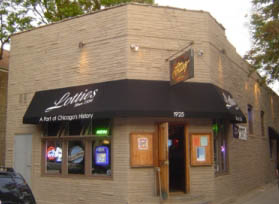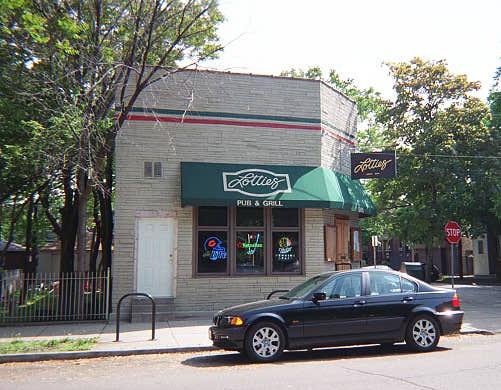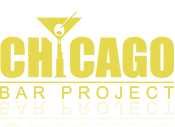“Best of Bucktown”
 Like many bars in Bucktown, Lottie’s appears to be less-than-inviting from the outside, but it’s a different story within. You’ll find Lottie’s to be a lively joint and as close to a sports bar as you’re going to get in this Bohemia-cum-Boutique neighborhood of Bucktown. From a barstool, you can ponder Lottie’s colorful former owner for which it is named, along with its intriguing history as grocery store, gambling hall, prostitution den, and strip tease joint. No wonder why Nelson Algren frequented the place, as his writings focused on the underbelly of society. Otherwise, have a game of darts or pool and, if the weather’s nice, grab yourself a grilled cheese with crinkle cut fries out in the sidewalk café.
Like many bars in Bucktown, Lottie’s appears to be less-than-inviting from the outside, but it’s a different story within. You’ll find Lottie’s to be a lively joint and as close to a sports bar as you’re going to get in this Bohemia-cum-Boutique neighborhood of Bucktown. From a barstool, you can ponder Lottie’s colorful former owner for which it is named, along with its intriguing history as grocery store, gambling hall, prostitution den, and strip tease joint. No wonder why Nelson Algren frequented the place, as his writings focused on the underbelly of society. Otherwise, have a game of darts or pool and, if the weather’s nice, grab yourself a grilled cheese with crinkle cut fries out in the sidewalk café.
Located on the corner of Cortland and Winchester in Wicker Park, Lottie’s appears to be one of the few, fairly normal neighborhood bars in the midst of other dark and swanky places like Northside, Danny’s Tavern, and Club Lucky. Normalcy lies in the eye of the beholder, while the truth can present a different story. Lottie’s Pub dates back at least to 1928, when it was operated as the grocer of Wladislaus and Rose Behrendt. In 1934, the establishment was acquired by Walter “Lottie” Zagorski who ran the place as “Zagorski’s Tavern.” Walter went by the name “Lottie,” as he was a flamboyant transvestite, and possible hermaphrodite, that stood six feet tall and could personally “escort” unruly patrons out the door single-handedly. Lottie was as infamous as she was colorful. She ran a gambling operation in the basement, dubbed “Zagorski’s Rathskeller.” Access to the Rathskeller was through a private door and the place catered to gangsters, neighborhood residents and politicians alike. It is said that the gambling operation was run by Andy “The Greek” Lochious, working for Joseph “Joe Gags” Gagliano, a syndicate gambling and loan shark boss. According to the Lottie’s website, “A simple knock on Lottie’s private basement door opens a world of escape and debauchery — lively parties, strip tease dancers, horse betting, and all-night poker games to those deemed worthy.” Lottie was arrested as the leader of the bookmaking ring a couple of times and, following a joint crackdown by the FBI and IRS, and subsequent grand jury testimony, she died of natural causes in 1973. Zagorski’s closed a year later.
“The basement, known back then as Zagorski’s Rathskeller, was allegedly a party joint for politicians and gamblers and a spot where Lottie entertained Chicago’s finest. It is even rumored that the bar had a separate basement entrance, so that known characters of years past could avoid the public eye as they entered Lottie’s underworld… Since its closing in the 1960s, the Rathskeller underneath and the bar above have been transformed into a series of neighborhood pubs and taverns and have gained a reputation as a nice place to sit down, watch sports and have a good brew.”
– excerpt from Melissa Lou’s article, “Bones discovered in basement of Wicker Park sports bar” as reported in the Medill Chicago News Service (January 14, 2004)
What was once Zagorski’s later became Busia’s Polish Pub in the 1980s and is described as having been a multigenerational neighborhood tap, and center of Polish political doings. Dan Rostenkowski’s dad used to come in. Good ol’ Rosty. The pub was then re-opened by Bill Lockhart in 1986 and named, “Lottie’s Pub & Grill” to commemorate former owner, Lottie Zagorski. Bill also kept memorabilia on hand from Zagorski’s Tavern and Lottie herself, including an old black and white photograph on the bar’s west wall of a manly-looking Lottie in a flower-print dress.
Today, Lottie’s is one of those places that only have a few windows, choked with neon beer signs, so that you don’t know what to expect when you walk inside. It’s up a few cement steps and through the unfinished wooden door, and you’re in. You’ll find a large room with exposed brick walls, wooden slat ceiling lined with white string lights, and a dark mahogany bar that runs along the length of the eastern wall. Here you’ll find 25 beers on tap. Behind the bar are yellow and blue beveled lights with a stained glass Schlitz light, and large wooden coolers hold another two-dozen beers in bottles. Lottie’s also features a half-dozen wines by the glass and a menu of “bombs.” Sure, you know Jäger Bombs (Jägermeister served in an 8-ounce glass with Red Bull) and Irish Car Bombs (Jameson and Baileys dropped into a 1/4 pint of Guinness), but have you ever had a Lunar Bomb? If not, its a shot of some kind of 99 proof orange liqueur dropped into a 1/4 pint of Blue Moon, of which drinking could lead to your own incident).
On your right are several tables and chairs – a good place to enjoy some pub grub consisting of the usual array of appetizers, burgers, sandwiches, and grilled cheese served on Texas Toast. Bonus: crinkle cut fries and baskets of tater tots for $3 (take that, Take Five). Several flatpanels dutifully show Cubs, Bulls and Bears games and Lottie’s is also the official watch site for the Chicago Branch of the Kansas Alumni Association, so you’ll also find all Jayhawks games. For those feeling a bit restless, you can have a go on the electronic dartboard, or one of the two pool tables in the back. Sadly, the two-player Galaga up that was once located up front has disappeared. Upon the transition of ownership to Mark Domitrovitch recently, the party room recently renovated from something resembling your parents’ rec room into a stylish space with hardwood floors, exposed brick walls, a mahogany bar that runs half the length of the eastern wall, and low swanky brown couches. While they initially caused a stir, the bones dug up as part of the renovation were not from a gangster or unlucky gambler, but rather that of an animal that died of indeterminate causes. The sidewalk café is also good in the summertime, particularly with the string lights adorning the trees.
Like the Pink Poodle Tavern, Tip Top Tap (Magnificent Mile) and nearby Rainbo Club (Wicker Park), legendary Chicago writer Nelson Algren used to frequent what is now Lottie’s, as this was the neighborhood he spent most of his adult life in. Perhaps he was lured into the Zagorski’s Rathskeller for the “entertainment” or to rub elbows with the disenfranchised that were so prominent in his writings, or maybe it was just that it was a good place to grab a beer with Simone de Beauvoir because of its proximity to his old apartment at 1958 W. Evergreen Avenue that you can still see today.
“Between the curved steel of the El and the nearest Clark Street hockshop, between the penny arcade and the shooting gallery, between the basement gin-mill and the biggest juke in Bronzeville, the prairie is caught for keeps at last. Yet on nights when the blood-red neon of the tavern legends tether the arc-lamps to all the puddles left from last night’s rain, somewhere between the bright carnival of the boulevards and the dark girders of the El, ever so far and ever so faintly between the still grasses and the moving waters, clear as a cat’s cry on a midnight wind, the Pottawatomies mourn in the river reeds once more.”
– excerpt from Chicago: City on the Make by Nelson Algren (1951)
Nowadays, the place primarily attracts a local neighborhood crowd and is rather tame in comparison to its checkered past. I used to know a group of people from Berwyn that loved Lottie’s and frequented it on weekends. For them, Lottie’s was an adventurous departure from staying home and watching early Woody Allen films. Others have criticized Lottie’s for being more of a Lincoln Park type bar, particularly when all the TVs are turned up. I think of Lottie’s more as an oasis in a sea of madness, even though it used to be the opposite when Lottie ran the place. All in all, Lottie’s is a good place to chill out, have a bit of a chat, and lament the influx of Yuppies into Wicker Park. For more information check out the Lottie’s website. Go Cubbies!
“But I did not forget the Chicago Bowery, the little Polish bars, the cold wind; I’ll never forget them.”
– excerpt from a letter written by Simone de Beauvoir to Nelson Algren (New York, March 15, 1947)


Photo courtesy of Carl Stumpf
